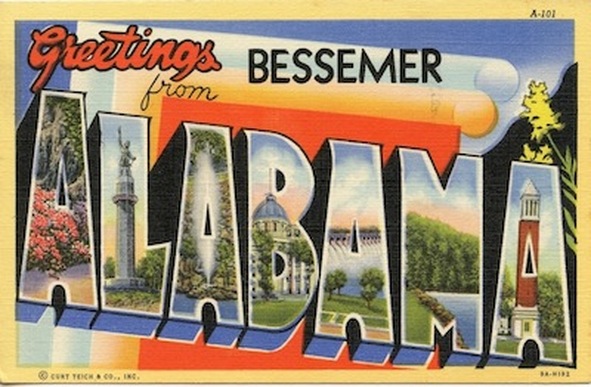|
The Breadcrumbs widget will appear here on the published site.
The Mayor By Terry Barr QuailBellMagazine.com I’m sitting in my mother’s den watching my daughters take turns brushing Pepper, my mother’s Maine Coon. Mom is watching “Dateline,” another grisly episode about a husband murdering his wife. Two former Baptist missionaries, the voiceover tells us. “Hhhmph,” Mom says. “Baptist missionaries my foot!” I love her righteous indignation, maybe because it’s her most familiar default, reminding me of front porch chats or her end of neighborly phone calls. The “Dateline” narrative continues, and I turn back to reading Alabama football message boards. We’re in town for tomorrow’s game, Alabama versus Southern Mississippi. Not a great matchup, but all I could manage given costs and my daughters’ availability from work and school. As I read about the ongoing quarterback controversy—an old story between champions of either the Black or a white quarterback—I realize that my mother is in mid-sentence, addressing me: “…that time when Frank Sinatra, Jr. sang at the Knights of Columbus Hall in Bessemer?” “When I was in high school? Yeah, I remember. I double-dated that night with Jimmy Walker. Sarah Monte asked him to go, and Pat Pace asked me. I’ll never forget it. Pat’s father was a detective on the Bessemer force. When he opened the door and got a look at me with my long red hair, I felt like I was the most likely suspect ready for a police lineup. He never said a word to me, and that was the only date I had with Pat Pace.” “OK, but do you remember what a fool Jess Lanier made of himself that night?” Jess Lanier was Bessemer’s longtime mayor. I’m guessing that the year of that show was 1973, so by then Lanier had been mayor for at least twelve years, which would seem to confirm a status of “beloved,” for His Honor. I remember having my picture made with him in his office when I was a Cub Scout. He was officially recognizing Scout Week, and there were two older scouts in the office too. In the photograph, the Mayor leans over his desk from his leather-backed swivel chair to sign the official proclamation. He looks up at the camera as he signs, and smiles. Flanking him, the three of us smile too like I’m sure we’ve been asked to. I have no more idea now why I was selected for this honor than I did then. I think now that it’s too bad Pat Pace’s father hadn’t seen that picture—me in uniform with the Mayor and with my very buzzed crew cut. But maybe, given all that would happen that night, leaving the Mayor out of our meeting was best. Mayor Lanier’s voice had that medium-hoarse Southern quality endemic to those who considered themselves true gentlemen. He tried to put us at ease with small talk. I kept thinking, “Here I am in a mayor’s office. I wonder what happens here?” I had seen the mayor before at our church, First Methodist. He came irregularly but always made a grand entrance a minute or two before services started. His daughter, Gingah, had been my Bible School teacher the previous summer. She was also head majorette at Bessemer High. Imagine. Our photo appeared in the following week’s Bessemer Cutoff News, a weekly Thursday insert in The Birmingham News. My mother taped it into my baby book. I think it’s still there. My smile is the usual one: all lips and no teeth. But what strikes me the most is that the Mayor’s pose is identical to the ones of him published every week signing yet another proclamation favoring our town. If I hadn’t been in his presence, I’d think he was a life-sized cutout, trying to prove that he did something while serving our city. And he did do some things. Jess Lanier mayored our town from the late 50’s through the mid-70’s which means he “led us” through the integration of our public spaces. I have no inside information of his Honor’s intentions, but here are a few things I do know about “his” Bessemer: Our cafes had separate rear entrances, or carry out windows, for “colored people,” at least until 1966. Our five-and-dime stores had separate lunch counters, drinking fountains, and one unisex restroom marked “colored.” I tried drinking from that colored-marked fountain in Pizitz Department store when I was a boy of three. The family who escorted me to downtown that day promptly escorted me away from the fountain and suggested I begin learning how to spell, starting with the words “white” and “colored.” I see this moment so clearly even after fifty-five years as I’m standing with my wife and mother in the old Pizitz building, now a United Fabric store, looking for material for our new curtains. I show my wife the spot on either side of the second floor elevator where those water fountains were. You can’t tell now that they were ever there, and I can’t decide if that’s a good thing or something very bad. It’s on this same floor that my mother bought my Cub Scout uniform, the one I wore in the picture with the Mayor. I remember watching the clerk select my golden kerchief and the rounded metal clap that bound it about my neck. That day my mother also bought me an official Cub Scout knife—though I couldn’t “play” with it, she said—and the certified Cub Scout Handbook. I remember learning the Cub Scout pledge that very night: “On My Honor, I will do my best to do my duty to be square, and to obey the laws of the pack.” Vague words, unknown laws. More than anything now, I can see the glass counter where the clerk stacked my new supplies. And my mother, our new “Den Mother,” proudly paying for them all. Our Mayor also oversaw the closing of Roosevelt Park’s public swimming pool in 1966, the only public pool in the city, where I had learned to swim the previous summer. The city fathers filled it with red dirt and then paved it smoothly with concrete. I guess they were serious about white and Black kids staying out of each other’s water. And of course Mayor Lanier regulated public school integration, which began in 1966, too. That was quite a year for Bessemer, and I know you can do the math, but anyway, our school system integrated itself twelve years after Brown versus Board of Education. So, born in 1956, by all rights I should never have spent any time in a segregated system. Of course, only certain citizens’ rights were ever at issue. It’s unfair to charge Lanier with being solely responsible for these officially-sanctioned events, but after all, he was the Mayor. He wanted to be the Mayor, and he kept getting re-elected just as his compatriot George Wallace kept being returned to the Montgomery Governor’s mansion (or if not Wallace, then his wife). “I’m a Wallace man,” Lanier once said, or could have. In fact, Jess Lanier was a Wallace delegate at the 1972 Democratic National Convention in Miami, at which Democrats embraced a new age of politics and causes. On the platform one of those prime-time convention nights stood an openly Gay man advocating Gay Liberation. I was on the verge of entering my junior year in high school that summer, and I’ll never forget that the week after the convention, one of my best friends, who would come out a few years later, called me: “You won’t believe it. Jess Lanier was quoted in Time Magazine. He’s angry because they’ve let queers speak at the convention. Isn’t that so typical of Bessemer?” You can read the mayor’s words on your own if you have access to the July 24, 1972, issue of Time (p. 24). If you don’t: “There on the podium at the convention was a certified member of Gay Liberation nonchalantly addressing the party…’Goddam,’ said Jess Lanier, mayor of Bessemer, Alabama. If that’s what they’re going to talk about, we’re never going to get this party together again. They haven’t got a dog’s chance of electing a President on this platform. Damn, do they need Wallace!” (“Dissidents: The Wallace Factor”) The literary analyst in me wants to go through every word of that quotation dissecting and deconstructing and reminding the readers of all the ironic nuances. But I’ll just leave it at the weirdly prophetic voice of the Mayor understanding that the Democrats had no chance in ’72, not with that platform, not with McGovern, and certainly not with the sitting President. I think now about Lanier’s image, the one he photographed to the rest of the country in that Time story. I think about his blustering on the convention floor, the behavior of an old-fashioned Southern demagogue. Of an old-fashioned Southern boor. Of a man who, on the night of the Frank Sinatra Jr show, demonstrated all that he was. “Don’t you remember what a fool Jess Lanier made of himself that night,” my mother continues. “When he got so drunk and insisted on making a speech at the intermission?” I remember the Knights of Columbus Hall, a nondescript white building on Bessemer’s lower, northern end. I can still see the four or five long tables decorated in white cloth and fresh spring flowers; my parents sitting somewhere behind me, and Jackie and Paula Lampkin sitting right across from me. Jackie and Paula are a mother-daughter team who deserve their own story one day, but on this night, for some reason, I ask Paula if I can have a sip of her water. Jackie—the archetype of all future Helicopter or Tiger Moms—shouts and grabs the glass away: “You’re not going to drink after Buddy Barr and get his germs!” I have no idea why I didn’t ask my own date for water. Maybe I was still thinking about her father, a lieutenant in Jess Lanier’s force. Despite all this, I remember listening to Sinatra Jr sing his father’s hits. He looked like his father and sounded like him too, for whatever that’s worth. I remember “Come Fly With Me,” and that when he veered into “Strangers in the Night,” at least one Italian mother swooned. Truthfully, his singing was pleasant enough even for a kid like me who preferred Santana or Neil Young. At least the dulcet refrains filled the more-than-awkward silence between Pat and me. To be fair, Pat looked very pretty that night, wavy hair flowing down her back, proudly displaying the wrist corsage I gave her. I’ll never know why she asked me to this show. Back then, I never believed a girl could have a crush on me. I’m tempted now to look her up on Facebook and message her to see if she remembers that night: the Lampkins and Frank Jr. And Jess Lanier who, according to my mother, drunkenly slurred the same stories over and over as he tried to welcome our visiting “star” to Bessemer, the “Marvel City,” at a club where Lanier wasn’t even a member, but at an event he figured deserved his official imprimatur. At this point, though, I have to add the one other change in Bessemer that transpired, or was instigated under Jess Lanier’s watch. As a boy I dreamed of attending Bessemer High, a three-story, reddish-brown brick structure that commanded an entire city block, just three streets west of the center of downtown. I could see myself standing on its grounds after school, strolling one block over to The Spinning Wheel for a milkshake with my friends before either walking or driving the nine blocks home. And in those dream-years, I never doubted that this would be my course. But in those dreams I also never counted on the 60’s, the convulsions of integration, and all that our city fathers would perform or enact to keep the affluent white kids in a school of their own. So when the courts ordered desegregation, and when it became apparent to everyone that Bessemer High was destined for a zone drawing a healthy percentage of “colored” kids, our city fathers built a new school in the trendier and wealthier western part of town. A lead-colored brick edifice in the shape of a tic-tac-toe grid, this new school boasted no windows. The architects and even the tenants, however, thought that the state-of-the-art sunken gymnasium more than made up for the darkness. Designed for only 800 students—there were exactly 800 lockers—in a city that on any given year contributed at least 3000 high school age kids, the plan would have been foolproof had the courts looked the other way, had they consented to another year of separation without representation. Had Bessemer been allowed to keep three ongoing public high schools: one all-Black (Abrams High on the east side), one all-white (the new school on the west side), and the other somewhere in-between (Bessemer High). The new school, someone decided, should be named for the Mayor, thus: Jess Lanier High found itself birthed. It’s the school Sarah Monte, Jimmy Walker, Pat Pace, and I attended for our entire high school life, along with 1700 other kids each year. For in the end, not even the eponymous Mayor could circumvent the courts or the reality of full integration. Old Bessemer High became a middle school and eventually the Kingdom Hall of Jehovah’s Witnesses. And while I never strode its grounds as a student, I did, as a member of the Thespian club, perform on its stage in my sophomore year play, Harvey. For among other forgotten features, Jess Lanier High had no auditorium. Still, at Jess Lanier High we students were always close. We shared lockers, rotating lunch periods, over-flowing classes and classrooms. We had an integrated student body, a football team with a star white quarterback and a star Black receiver who, back at Abrams High, had been the star quarterback. We had integrated faculty, coaches--all having been collapsed from the former segregated schools. We even had an integrated smoking section outside of the band room. Clearly, we had it all. Or at least some of us did. I doubt that the kids who rode the buses to school from as far as seven miles away thought so. They often got to school by 6:45 and then waited for their day to begin in that sunken gym where, I’m told, the heat never flourished in winter. Often, these same kids wouldn’t reach home until 5 or 5:30, even though the last bell rang at 3:00. People much younger than me ask now what school was like in those troubling days—how I handled the problems and tensions of race. I tell them that as a student who got dropped off at 7:50 by his parents every morning and whose ride was waiting at 3 every afternoon, I was always mindful of my privileges even when I was intimidated by the words, the anger, and sometimes the actual fights around me. Because with so much closeness, there were always people getting in your way, making you feel crowded and even disrespected. Making you lose your cool and act badly. Which brings me back to the end of my mother’s story. “That’s right. That Jess Lanier was making such a spectacle of himself that finally Margaret Bivona came up to the stage and told him off. She told him that he was embarrassing himself and everyone else, and that he should get off the stage and go home. She probably shouldn’t have done it, but he was being such a fool. And the next thing you know, he was rearing back and acting like he was going to hit her.” “Oh my God,” I said, and I wasn’t sure if the image was really coming back to me or if my mother’s description was so precise that I couldn’t help but see our Mayor looming over this little Italian woman. “Yessir. Pig House and Tommy Norton had to hold him back. If they hadn’t, I believe he would have sure nuff hit her!” Our Mayor, Jess Lanier, come to life. I wonder now, given the context, if he was merely doing things “his way” like he always had? But finally the Mayor was pacified, and Frank Jr. finished the show. Jimmy and I drove our dates home. I walked Pat to her door where her daddy was waiting. We were all very proper, very self-aware. But then, the only spotlight on us was our own. I don’t remember now the year Jess Lanier died. His wife followed him some years later, and just this past year, his daughter Gingah died of some form of cancer. The KC Hall where Jess Lanier almost hit Margaret Bivona, and Jackie Lampkin said my germs weren’t good enough for her daughter Paula, and the son of America’s greatest singer entertained 100 or so people on a brisk Bessemer Thursday night, fell into ruination a couple of decades ago. It’s been relocated near the rebuilt Catholic church close to Bessemer’s Super Wal-Mart, which itself is very near the new Bessemer City High School, an institution that is predominantly populated by African-American students. Jess Lanier High is now Bessemer City Middle School. I don’t know, because a gate now guards its entrance, but I guess it still has that sunken gym and no windows. However, both schools currently share the legendary nickname of old Bessemer High, a nickname dating back some eighty-plus years: the Purple Tigers. For after all, some things need to stay the same so that we’ll remember, and maybe so that others, younger than ourselves, will ask uncomfortable questions about echoing things they don’t quite, but feel they should, understand. So that when they do, we might be able to tell them why certain things were, or for so long, could never be. #Unreal #Mayor #Alabama #LocalPolitics #TownPolitics #CityPolitics #QuestionableLeadership #BadLeaders #BadPolitics Visit our shop and subscribe. Sponsor us. Submit and become a contributor. Like us on Facebook and follow us on Twitter. CommentsComments are closed.
|
|










